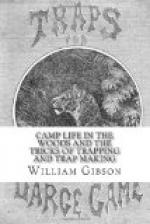[Page 154] THE FOX.
Foremost in the list of animals noted for their sly craft, and the hero of a host of fables and well-authenticated stories, in which artful cunning gains the advantage over human intelligence, Reynard, the fox, reigns supreme. There is scarcely a professional trapper in the land who has not, in his day, been hoodwinked by the wily strategy of this sly creature, whose extreme cunning renders him the most difficult of all animals to trap. The fox belongs to the Dog family, and there are six varieties inhabiting the United States. The red species is the most common and is too well known to need a description here. The Cross Fox considerably resembles the above, only being much darker in color, the red hair being thickly speckled with black. This species varies considerably in color in different individuals, often much resembling the red variety, and again approaching nearer in color to the Black or Silver Fox. This variation, together with the name of the animal, has given rise among trappers to the wide-spread belief of the animal being a cross between the two species which it so nearly resembles. It seems to be a permanent variety, however, the term cross being applied, we believe, on account of a dark marking on the back, between the shoulders of the animal, suggestive of that title. The Silver or Black Fox is the most beautiful and most rare of the genus, and yields the most valuable fur produced in this country. Its color is black, with the exception of the tip of the tail, which is white. The Prairie Fox is the largest of the species. It inhabits the Western Prairies, and in color resembles the common red variety, only being a trifle yellower.
The Kit, or Swift Fox, is smaller than the Red, and abounds in the Western States.
The Gray Fox is a Southern variety, and is very beautiful. It is less daring and cunning than the Common Fox, and seldom approaches a farm-yard, where it is in close proximity to a dwelling.
The general habits and characteristics of all the foxes are similar. For natural cunning they take the lead of all other animals. They are all built for speed, and their senses of smell and hearing are acutely developed. Their food consists of wild fowl of all kinds, rabbits, squirrels, birds and their eggs, together with many kinds of ripe fruits, “sour grapes” not included. They live in burrows, often usurped, or crevices between rocks; and their [Page 155] young, from three to nine in number, are brought forth in March.
We are strongly tempted to narrate a few remarkable instances of the animal’s cunning, but we forbear for want of space. Our reader must take it for granted that when he attempts to trap a fox, he will be likely to find more than his match in the superior craftiness of that animal. If the trap is overturned and the bait gone, or if repeatedly sprung and found empty, he must not he surprised or discouraged, for he is experiencing only what all other trappers have




